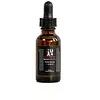What's inside
What's inside
 Key Ingredients
Key Ingredients

 Benefits
Benefits

 Concerns
Concerns

No concerns
 Ingredients Side-by-side
Ingredients Side-by-side

Sd Alcohol 40
AstringentEthoxydiglycol
HumectantPropylene Glycol
HumectantAlpha-Arbutin
AntioxidantKojic Acid
AntioxidantGlycerin
HumectantGlycyrrhiza Glabra Root Extract
BleachingMorus Alba Leaf Extract
Skin ConditioningPanax Ginseng Berry Extract
Skin ConditioningResveratrol
AntioxidantHydroxyethylcellulose
Emulsion StabilisingButylene Glycol
HumectantSodium Lactate
BufferingSodium PCA
HumectantGlycine
BufferingFructose
HumectantUrea
BufferingNiacinamide
SmoothingInositol
HumectantSodium Benzoate
MaskingLactic Acid
BufferingSd Alcohol 40, Ethoxydiglycol, Propylene Glycol, Alpha-Arbutin, Kojic Acid, Glycerin, Glycyrrhiza Glabra Root Extract, Morus Alba Leaf Extract, Panax Ginseng Berry Extract, Resveratrol, Hydroxyethylcellulose, Butylene Glycol, Sodium Lactate, Sodium PCA, Glycine, Fructose, Urea, Niacinamide, Inositol, Sodium Benzoate, Lactic Acid
Water
Skin ConditioningPropanediol
SolventNiacinamide
SmoothingBetaine
HumectantDimethyl Isosorbide
SolventTranexamic Acid
AstringentAcetyl Glucosamine
Skin ConditioningAlpha-Arbutin
AntioxidantUndecylenoyl Phenylalanine
Skin ConditioningGlycyrrhiza Glabra Root Extract
BleachingDipotassium Glycyrrhizate
HumectantTetrahydrodiferuloylmethane
AntioxidantHexylresorcinol
AntimicrobialDimethylmethoxy Chromanol
AntioxidantXanthan Gum
EmulsifyingLecithin
EmollientSclerotium Gum
Emulsion StabilisingPullulan
Disodium EDTA
Sodium Hydroxide
BufferingChlorphenesin
AntimicrobialCaprylyl Glycol
EmollientPhenoxyethanol
PreservativeEthylhexylglycerin
Skin ConditioningWater, Propanediol, Niacinamide, Betaine, Dimethyl Isosorbide, Tranexamic Acid, Acetyl Glucosamine, Alpha-Arbutin, Undecylenoyl Phenylalanine, Glycyrrhiza Glabra Root Extract, Dipotassium Glycyrrhizate, Tetrahydrodiferuloylmethane, Hexylresorcinol, Dimethylmethoxy Chromanol, Xanthan Gum, Lecithin, Sclerotium Gum, Pullulan, Disodium EDTA, Sodium Hydroxide, Chlorphenesin, Caprylyl Glycol, Phenoxyethanol, Ethylhexylglycerin
 Reviews
Reviews

Ingredients Explained
These ingredients are found in both products.
Ingredients higher up in an ingredient list are typically present in a larger amount.
Alpha-Arbutin is made from hydroquinone and glucose. It may also be derived from the fermentation of soybeans.
This ingredient an antioxidant, meaning it helps protect your skin cells against damage.
Studies show this ingredient helps improve hyperpigmentation and fade discoloration.
Alpha-Arbutin may be used with other ingredients that help with hyperpigmentation. These ingredients include retinol, Vitamin C, niacinamide, and tranexamic acid.
Learn more about Alpha-ArbutinGlycyrrhiza Glabra Root Extract is an extract of the roots of Licorice. It has been found to have several benefits such as skin hydrating, conditioning, and soothing.
One component, glabridin, has extra potent antioxidant and soothing properties. It has also been found to block pigmentation from UVB rays in guinea pigs.
Licorice Root also contains a flavonoid. Flavonoids are a natural substance from in plants. Flavonoids also have antioxidant properties.
Another component, glycyrrhizin, has been found to have anti-inflammatory and antimicrobial benefits. This may make licorice root extract effective at treating acne. However, more research is needed to support this.
Liquiritin is one of the flavone compounds found in licorice. It has been found to help lighten skin by preventing tyrosinase from reacting with tyrosine. When the two react, protein is converted to melanin. Melanin is the substance in your body that gives your features pigmentation.
Learn more about Glycyrrhiza Glabra Root ExtractNiacinamide is a multitasking form of vitamin B3 that strengthens the skin barrier, reduces pores and dark spots, regulates oil, and improves signs of aging.
And the best part? It's gentle and well-tolerated by most skin types, including sensitive and reactive skin.
You might have heard of "niacin flush", or the reddening of skin that causes itchiness. Niacinamide has not been found to cause this.
In very rare cases, some individuals may not be able to tolerate niacinamide at all or experience an allergic reaction to it.
If you are experiencing flaking, irritation, and dryness with this ingredient, be sure to double check all your products as this ingredient can be found in all categories of skincare.
When incorporating niacinamide into your routine, look out for concentration amounts. Typically, 5% niacinamide provides benefits such as fading dark spots. However, if you have sensitive skin, it is better to begin with a smaller concentration.
When you apply niacinamide to your skin, your body converts it into nicotinamide adenine dinucleotide (NAD). NAD is an essential coenzyme that is already found in your cells as "fuel" and powers countless biological processes.
In your skin, NAD helps repair cell damage, produce new healthy cells, support collagen production, strengthen the skin barrier, and fight environmental stressors (like UV and pollution).
Our natural NAD levels start to decline with age, leading to slower skin repair, visible aging, and a weaker skin barrier. By providing your skin niacinamide, you're recharging your skin's NAD levels. This leads to stronger, healthier, and younger looking skin.
Another name for vitamin B3 is nicotinamide. This vitamin is water-soluble and our bodies don't store it. We obtain Vitamin B3 from either food or skincare. Meat, fish, wheat, yeast, and leafy greens contain vitamin B3.
The type of niacinamide used in skincare is synthetically created.
Learn more about Niacinamide